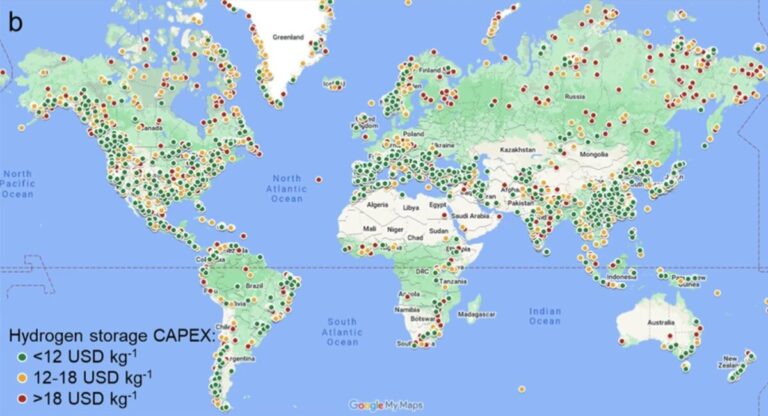Researchers from King Abdullah University of Science and Technology said this pv magazine that hydrogen storage and gravel pipelines could become a reality within ten years in lakes or water reservoirs in Europe, the United States, Japan or China. “The technology needed to implement the proposed system is available, simple and cheap,” they said.
King Abdullah University of Science and Technology researchers have suggested using high-density polyethylene (HDPE) pipelines – filled with gravel, tailings or sand – to store hydrogen in lakes and reservoirs as a competitive long-term storage option where salt caverns are not available. “The cheapest option is to use mining tailing, as this would also solve the problem of where the waste material from the mines should go. Gravel is usually expensive. Sand is a cheaper option,” said researcher Julian Hunt pv magazine. The proposed storage solution requires a deep hydropower reservoir or more. “The reason why storing hydrogen pipes and gravel in lakes and reservoirs is cheap is because the pressure inside the tank is always equal to the pressure outside the tank at a fixed depth” said Hunt. “This is good because the pipeline does not need to be reinforced with carbon fiber, which is expensive. The pressure of the tank increases by 1 bar with an increase in depth of 10.2 meters.” In addition to depth, flat bottoms in water reservoirs are crucial to prevent sediment flow from damaging the tanks, Hunt said. “The tanks would still function under the sediments,” he said. “However, if there are leaks in the pipeline, it may not be possible to repair the tank.” The mainly safety consideration for the proposed storage approach is to avoid or monitor navigation over the storage tanks. “If it is a large object is dropped from the surface or a boat sinks and hits the pipeline, it can damage the pipeline and release H2. H2 emissions will not affect aquatic life, and the risk of explosions on the surface is low because the hydrogen will rise quickly into the atmosphere,” Hunt said. “The main impact on the environment is the existence of large pipelines at the bottom of the lake/reservoir, which could disturb the fauna and flora at the bottom of the reservoir.” He noted that the H2 extracted from the tank will contain trace amounts of water vapor, about 0.1%, depending on the depth and temperature of the tank. “This could be a problem if the H2 requirements in future networks are as well terribly pure,” he said. In “Hydrogen storage with gravel and pipes in lakes and reservoirs” – recently published in Nature communication – the team said so the proposed storage system could become a reality in ten years.
Iberdrola said it has reached a final investment decision with BP for a 25 MW green hydrogen project at BP’s refinery in Castellón, Spain, due to start in late 2026. said the joint venture, Castellón Green Hydrogen SL, is equally owned by both companies. It will benefit from €15 million ($16.6 million) in funding from the Spanish government and NextGenerationEU. The project includes a 25 MW electrolyzer powered by renewable energy under a power purchase agreement with Iberdrola España. Plug Power will supply five of 5 MW proton exchange membrane (PEM) modules.
Imagine said it will build Europe’s first integrated green hydrogen net-zero industrial park with support from the Spanish government, industrial partners and financial companies. The Shanghai-based company said The project will play a role in reaching 5 GW of electrolysis capacity, allowing Spain to reach its Hydrogen Roadmap target of 11 GW by 2030. The $1 billion investment from Envision and its partners is expected to create 1,000 new green jobs. The deal was confirmed during Spanish Prime Minister Pedro Sanchez’s recent visit to China, and construction should begin in early 2026.
Industry De Nora and Asahi Kasei have agreed to develop and commercialize containerized, modular pressurized electrolyzers for small-scale green hydrogen production. Industry De Nora will use its gigafactory – now under construction near Milan, Italy – to advance its electrolyzer design, while Asahi Kasei will drive sales and provide global after-sales support.
Deutsche ReGas said it has completed the front-end engineering and design phase (FEED) for the H2 Hub Lubmin in Germany. The company plans to build a 200 MW electrolysis plant by the end of 2026, with another 500 MW to be added by 2028. announced the development of the Lubmin H2 import terminal, which will become operational in 2026.
This content is copyrighted and may not be reused. If you would like to collaborate with us and reuse some of our content, please contact: editors@pv-magazine.com.


